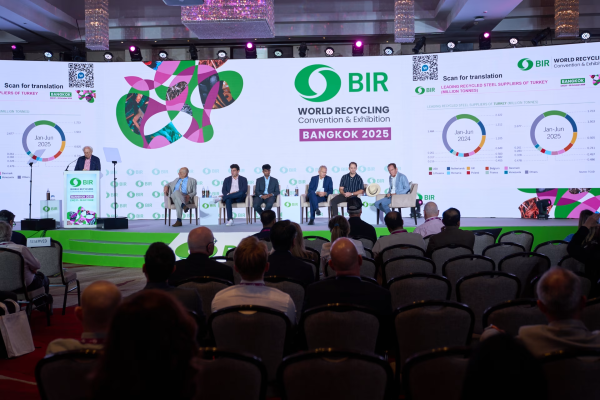At Bureau of International Recycling (BIR) World Recycling Convention in Bangkok on October 27-28, 2025, industry leaders highlighted how shifting global trade dynamics, new sustainability priorities, and updated steel-recycling statistics are reshaping the recycling sector.

In his keynote address, Juan Verde, adviser to former US Presidents Biden, Obama, and Clinton, said the world is at “a historic crossroads” where old trade rules no longer apply. He identified three forces reshaping recycling: the rise of China, technological rivalry and protectionism, and the redefinition of sustainability. Verde explained that geopolitical competition over resources, along with advances in AI, quantum computing, and biotechnology, will transform global industries and boost demand for recycled materials. He noted that protectionist policies such as “friend-shoring” will drive countries to invest heavily in recycling capacity to strengthen resource security.
At the Ferrous Division meeting of the convention, Rolf Willeke, BIR Ferrous Statistics advisor, highlighted the key findings in the January-June 2025 update of the 16th edition of “World Steel Recycling in Figures”. From BIR’s calculations, roughly 630 million mt of recycled steel is used annually, preventing 950 million mt of carbon emissions and conserving energy and resources.
For green steelmaking, Mr. Willeke stated that it is important to follow global trends affecting the use of direct reduced iron (DRI). In the first half, global DRI production rose by 4.3 percent year on year to 64.2 million mt, and the two largest producers were India with 29.2 million mt and Iran with 16.3 million mt.
Recycled-steel usage declines globally
Global recycled-steel consumption in key regions fell 6.9 percent year on year to 235.96 million mt, covering 76 percent of world steelmaking. Recycled steel usage headed lower in China, the EU-27, the US, Japan and South Korea in the first half of 2025 whereas increases were registered in India and Turkey.
- China: 109.01 million mt (-11.4%) – still the world’s largest user
- EU-27: 39.4 million mt (-4.2%)
- USA: 26.7 million mt (-9.1%)
- Japan: 14.9 million mt (-6.7%)
- South Korea: 10.24 million mt (-11.3%)
- India: 19.65 million mt (+15.3%)
- Turkey: 16.05 million mt (+2.2%)
Recycled steel’s share of crude-steel output was 21.2 percent in China, 24.5 percent in India, 33.4 percent in South Korea, 36.7 percent in Japan, 60.2 percent in the EU-27, 66.4 percent in the US, and 87.7 percent in Turkey.
Trade in recycled steel
Turkey remained the largest importer, buying 9.4 million mt of recycled steel, mainly from the US and the Netherlands, while India ranked second with 4.58 million mt.
The EU-27 stayed the top exporter of recycled steel at 8.3 million mt, followed by the US at 6.0 million mt. Export growth was notable in Japan (+19.5%), Mexico (+27.4%), and Singapore (+32.6%), while declines were recorded for the UK (-25.4%), Australia (-46.8%), and Canada (-13.2%).
Both the EU and US remained net exporters, with surpluses of 5.8 million mt and 3.8 million mt, respectively. Export prices in both regions moved largely in parallel during the first half of 2025.